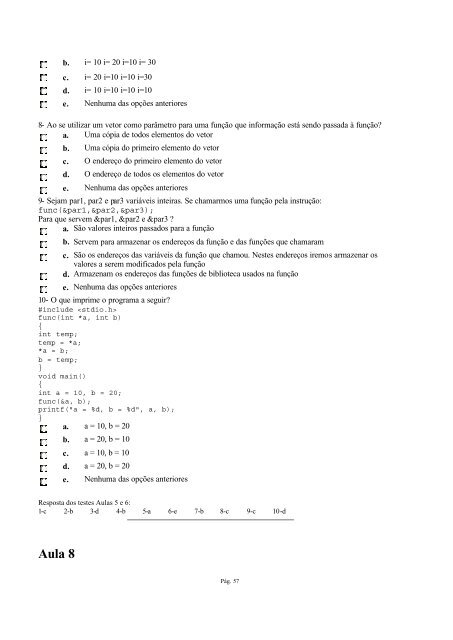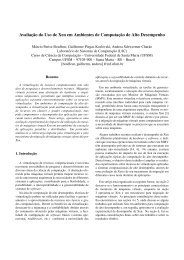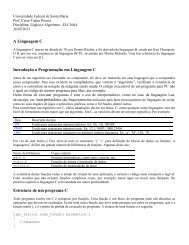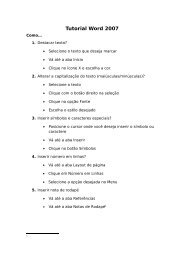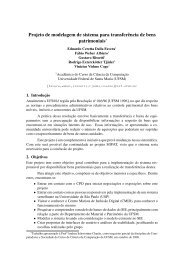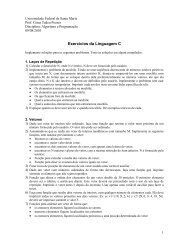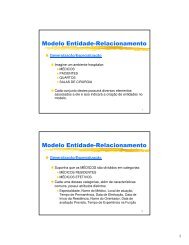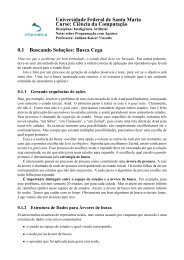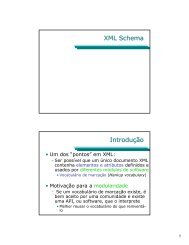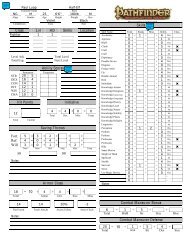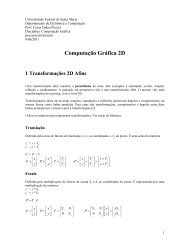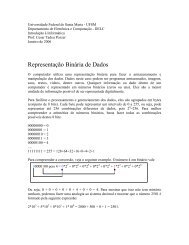Apostila C da UFMG - Universidade do Minho
Apostila C da UFMG - Universidade do Minho
Apostila C da UFMG - Universidade do Minho
You also want an ePaper? Increase the reach of your titles
YUMPU automatically turns print PDFs into web optimized ePapers that Google loves.
. i= 10 i= 20 i=10 i= 30<br />
c. i= 20 i=10 i=10 i=30<br />
d. i= 10 i=10 i=10 i=10<br />
e. Nenhuma <strong>da</strong>s opções anteriores<br />
8- Ao se utilizar um vetor como parâmetro para uma função que informação está sen<strong>do</strong> passa<strong>da</strong> à função?<br />
a. Uma cópia de to<strong>do</strong>s elementos <strong>do</strong> vetor<br />
b. Uma cópia <strong>do</strong> primeiro elemento <strong>do</strong> vetor<br />
c. O endereço <strong>do</strong> primeiro elemento <strong>do</strong> vetor<br />
d. O endereço de to<strong>do</strong>s os elementos <strong>do</strong> vetor<br />
e. Nenhuma <strong>da</strong>s opções anteriores<br />
9- Sejam par1, par2 e par3 variáveis inteiras. Se chamarmos uma função pela instrução:<br />
func(&par1,&par2,&par3);<br />
Para que servem &par1, &par2 e &par3 ?<br />
a. São valores inteiros passa<strong>do</strong>s para a função<br />
b. Servem para armazenar os endereços <strong>da</strong> função e <strong>da</strong>s funções que chamaram<br />
c. São os endereços <strong>da</strong>s variáveis <strong>da</strong> função que chamou. Nestes endereços iremos armazenar os<br />
valores a serem modifica<strong>do</strong>s pela função<br />
d. Armazenam os endereços <strong>da</strong>s funções de biblioteca usa<strong>do</strong>s na função<br />
e. Nenhuma <strong>da</strong>s opções anteriores<br />
10- O que imprime o programa a seguir?<br />
#include <br />
func(int *a, int b)<br />
{<br />
int temp;<br />
temp = *a;<br />
*a = b;<br />
b = temp;<br />
}<br />
void main()<br />
{<br />
int a = 10, b = 20;<br />
func(&a, b);<br />
printf("a = %d, b = %d", a, b);<br />
}<br />
a. a = 10, b = 20<br />
b. a = 20, b = 10<br />
c. a = 10, b = 10<br />
d. a = 20, b = 20<br />
e. Nenhuma <strong>da</strong>s opções anteriores<br />
Resposta <strong>do</strong>s testes Aulas 5 e 6:<br />
1-c 2-b 3-d 4-b 5-a 6-e 7-b 8-c 9-c 10-d<br />
Aula 8<br />
Pág. 57


